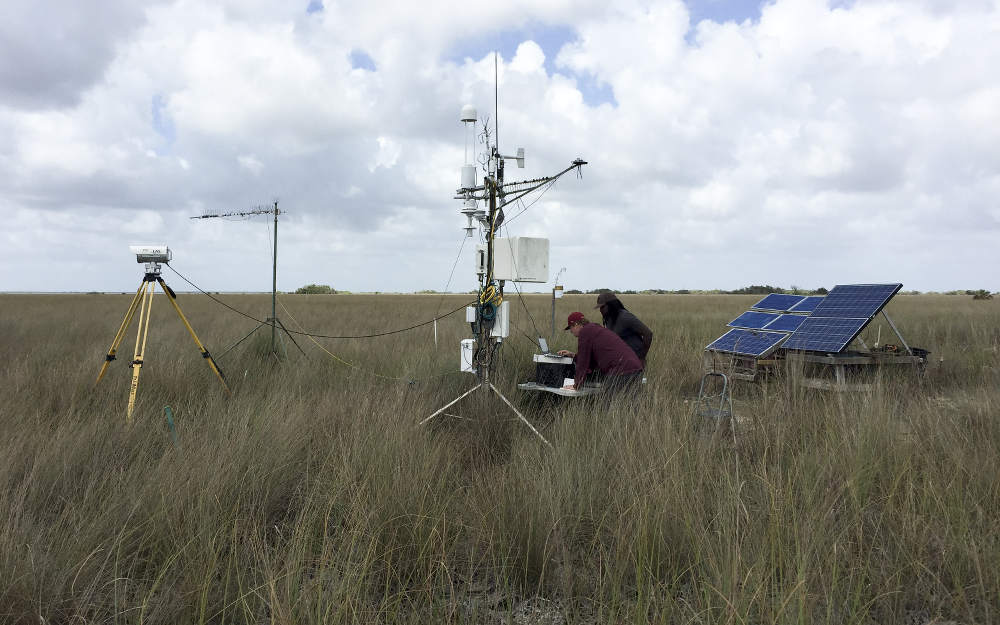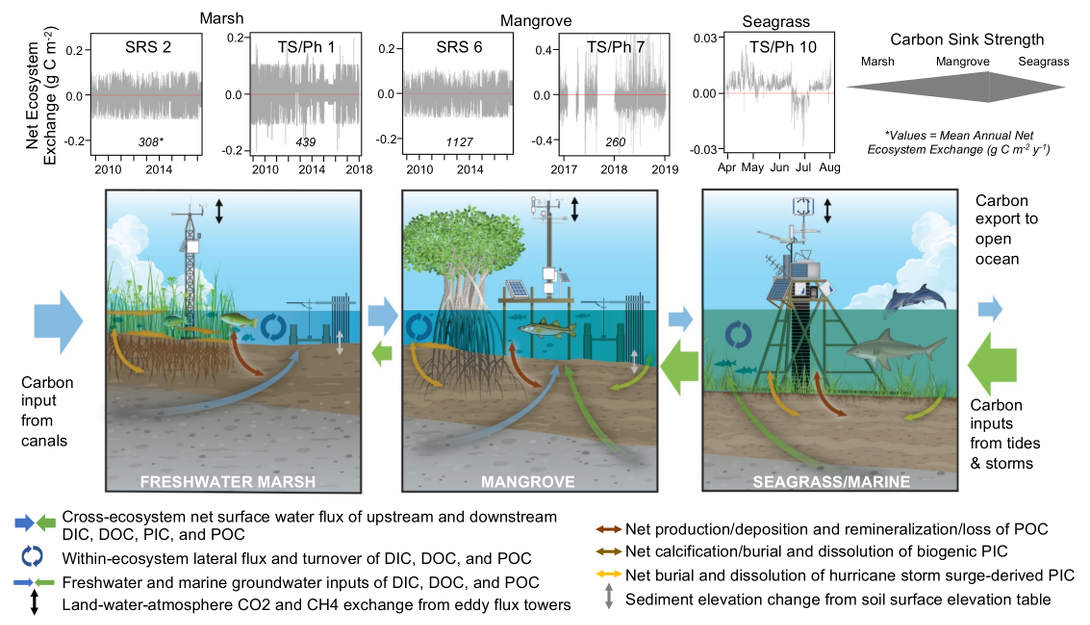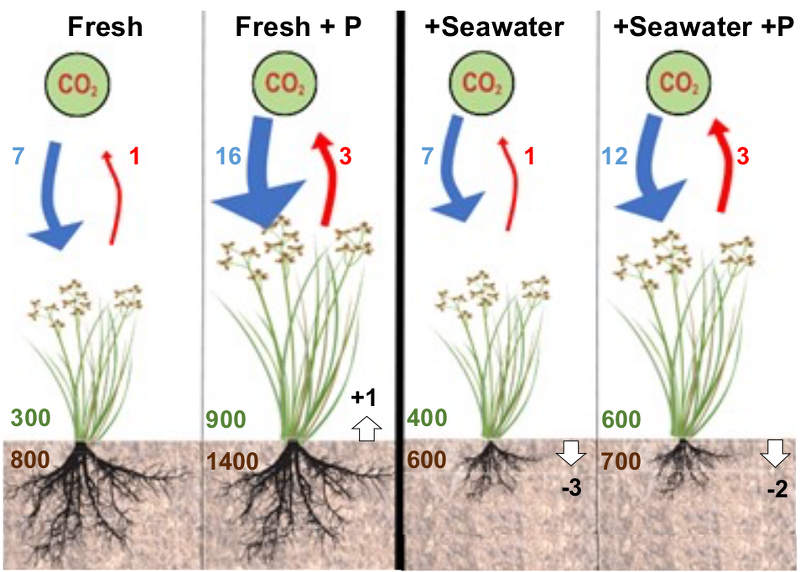- Key Findings
Rising seas can stimulate the inland transgression of mangroves and amplify carbon gains (as observed in historic carbon budgets based on long term flux data, paleoecology, and remote sensing). However, FCE LTER studies, experiments, and models show that carbon losses can exceed increases where saltwater invades freshwater marshes, resulting in abrupt elevation loss (collapse) that further promotes saltwater intrusion (Wilson et al. 2019).

Eddy covariance and meteorological tower near TS/Ph-1b in Taylor Slough. Credit: Edward Linden - Results
 Net ecosystem carbon balance in the FCE is measured by the net ecosystem exchange of CO2 and CH4 (from our eddy flux tower data in upper graphs), the production, mineralization, and fluxes of dissolved inorganic carbon (DIC), dissolved organic carbon (DOC), particulate inorganic carbon (PIC), and particulate organic carbon (POC) within and between marsh, mangrove, and seagrass/marine ecosystems. Net soil elevation change is measured with surface elevation tables.
Net ecosystem carbon balance in the FCE is measured by the net ecosystem exchange of CO2 and CH4 (from our eddy flux tower data in upper graphs), the production, mineralization, and fluxes of dissolved inorganic carbon (DIC), dissolved organic carbon (DOC), particulate inorganic carbon (PIC), and particulate organic carbon (POC) within and between marsh, mangrove, and seagrass/marine ecosystems. Net soil elevation change is measured with surface elevation tables. 
Freshwater marsh response to saltwater intrusion from manipulations of phosphorus (+ 15 µmol P d-1) and seawater (9 ppt NaCl). Responses include changes in carbon dioxide flux (blue and red arrows, µmol CO2 m2 s-1), biomass of above and belowground vegetation (green and brown numbers, respectively, in g m-2, respectively) and soil elevation gain or loss (arrows, in cm).
- Related Publications
Jimenez, K.L., G. Starr, C. Staudhammer, J. Schedlbauer, H. Loescher, S.L. Malone, S. Oberbauer. 2012. Carbon dioxide exchange rates from short- and long-hydroperiod Everglades freshwater marsh. Journal of Geophysical Research 117: G04009. DOI: 10.1029/2012JG002117
Malone, S.L., C. Staudhammer, H. Loescher, P.C. Olivas, S. Oberbauer, M.G. Ryan, J. Schedlbauer, G. Starr. 2014. Seasonal patterns in energy partitioning of two freshwater marsh ecosystems in the Florida Everglades. Journal of Geophysical Research: Biogeosciences 119(8): 1487-1505. DOI: 10.1002/2014JG002700
Malone, S.L., G. Starr, C. Staudhammer, M.G. Ryan. 2013. Effects of simulated drought on the carbon balance of Everglades short-hydroperiod marsh. Global Change Biology 19: 2511-2523. DOI: 10.1111/gcb.12211
Schedlbauer, J., J. Munyon, S. Oberbauer, E.E. Gaiser, G. Starr. 2012. Controls on ecosystem carbon dioxide exchange in short- and long-hydroperiod Florida Everglades freshwater marshes. Wetlands 32: 801-812. DOI: 10.1007/s13157-012-0311-y
Schedlbauer, J., S. Oberbauer, G. Starr, K.L. Jimenez. 2010. Seasonal differences in the CO2 exchange of a short-hydroperiod Florida Everglades marsh. Agricultural and Forest Meteorology 150(7-8): 994-1006. DOI: 10.1016/j.agrformet.2010.03.005
Schedlbauer, J., S. Oberbauer, G. Starr, K.L. Jimenez. 2011. Controls on sensible heat and latent energy fluxes from a short-hydroperiod Florida Everglades marsh. Journal of Hydrology 411: 331-341. DOI: 10.1016/j.jhydrol.2011.10.014
Troxler, T., E.E. Gaiser, J.G. Barr, J.D. Fuentes, R. Jaffe, D.L. Childers, L. Collado-Vides, V.H. Rivera-Monroy, E. Castañeda-Moya, W.T. Anderson, R.M. Chambers, M. Chen, C. Coronado-Molina, S.E. Davis, V. Engel, C. Fitz, J.W. Fourqurean, T.A. Frankovich, J. Kominoski, C.J. Madden, S.L. Malone, S. Oberbauer, P.C. Olivas, J.H. Richards, C.J. Saunders, J. Schedlbauer, L.J. Scinto, F.H. Sklar, T.J. Smith, J.M. Smoak, G. Starr, R.R. Twilley, K.R.T. Whelan. 2013. Integrated carbon budget models for the Everglades terrestrial-coastal-oceanic gradient: current status and needs for inter-site comparisons. Oceanography 26: 98-107. DOI: 10.5670/oceanog.2013.51
Wilson, B.J., S. Servais, S.P. Charles, V. Mazzei, E.E. Gaiser, J. Kominoski, J.H. Richards, and T. Troxler. 2019. Phosphorus alleviation of salinity stress: effects of saltwater intrusion on an Everglades freshwater peat marsh. Ecology 100: e02672. DOI: 10.1002/ecy.2672
For more information, contact Gregory Starr or Sparkle Malone.